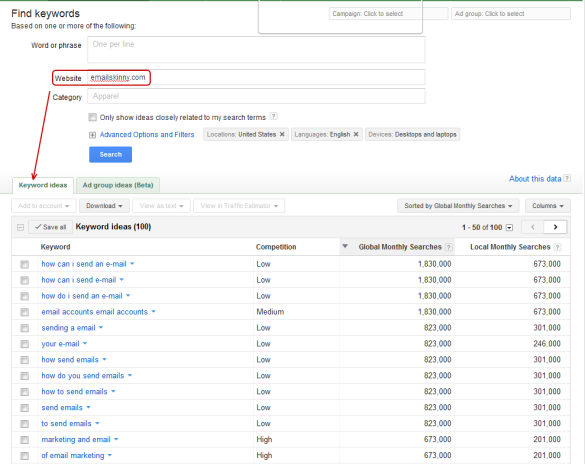In August, Google announced that it was testing a new feature that would include search results from a user’s own Gmail account on search results pages. (If you want to see it in action on your own mail box, Google is still accepting users in the field trial.) Participants will now see results from their Gmail account appear in a separate column on the right side of the results page, like this:
This is a remarkable opportunity for e-mail marketers for a pair of reasons. First, it can extend the shelf-life of their messaging indefinitely. Even if the recipient failed to interact with the message at the time it was received, the message can re-appear before their eyes when they perform Google searches on related content. Second, senders now may have valuable additional opportunities to re-engage with their subscribers without actually sending more mail.
That’s an important concept from a deliverability standpoint. If you’re having a tough time coming up with the right content for your campaign to drive recipient engagement, sending more mail to subscribers who are no longer interested is just about the last thing you want to do:
- We learned just last month that Yahoo! Mail is using even more extensive engagement data from their users to drive automated delivery decisions;
- Outlook/Hotmail implemented a series of hands-free filtering schemes that “sweep” unengaging e-mail from recipients’ inboxes, and;
- Gmail Priority Inbox punishes unengaging senders by denying them inbox, or with poor positioning within the inbox.
The trend is clear and and accelerating: senders who persist in sending mail that can’t inspire even a minimal amount of interest on the part of their subscribers will see their deliverability suffer.
So, now that we see the opportunity, the question becomes how to make the best use of it. Senders can optimize their messaging for engagement with a little free research and testing, and once again it’s Google to the rescue.
Pepper the subject line and content with keywords and phrases your recipients are searching for. Create a free Google AdWords account, and use the Keyword Tool to see which terms people are searching for on Google that are specific to your industry, products or even to your own web site:
Here, I’ve typed in the URI for the E-mail Skinny blog, and unsurprisingly, the list of keyword ideas has much to do with sending e-mail in large volumes. But within those results are a couple of phrases I might not have come up with on my own, like “email list software” and “email list hosting”. Far fewer industry-specific terms, like “deliverability” or “acceptance rate” appear on the results than I expected.
Next, make a list of those terms that have the highest number of monthly searches and incorporate them into your creative. But don’t just paste them into the bottom of your message; ISPs are on the watch for “word salad”, a tactic used by spammers to evade certain types of content filters. Work them into the natural narrative of your message to boost engagement and inbox search results.
Now test, test, test! Most ESPs provide A/B testing modules that lets senders automatically test variables in a message head to head with small groups of recipients. Find which changes and content result in the highest open and click rates, and roll them out to the rest of your recipients.
The incorporation of Gmail inbox content into Google search results emphasizes not only the growing importance of engagement in deliverability, but presents interesting opportunities to actually improve it. Savvy senders will find what kind of content works best for their subscribers, and use it to squeeze as much Google juice – and ROI – out of their programs as they can.



Great article. The other thing I noticed myself doing when I have a bunch of emails is just scanning for keywords in the subject line (another good reason to do as you suggested).
Other than that, I’ve seen other folks change their ‘From’ name to say “Andrew at ProspectSnap” instead of “ProspectSnap Newsletter” or “noreply@prospectsnap.com”
LikeLike